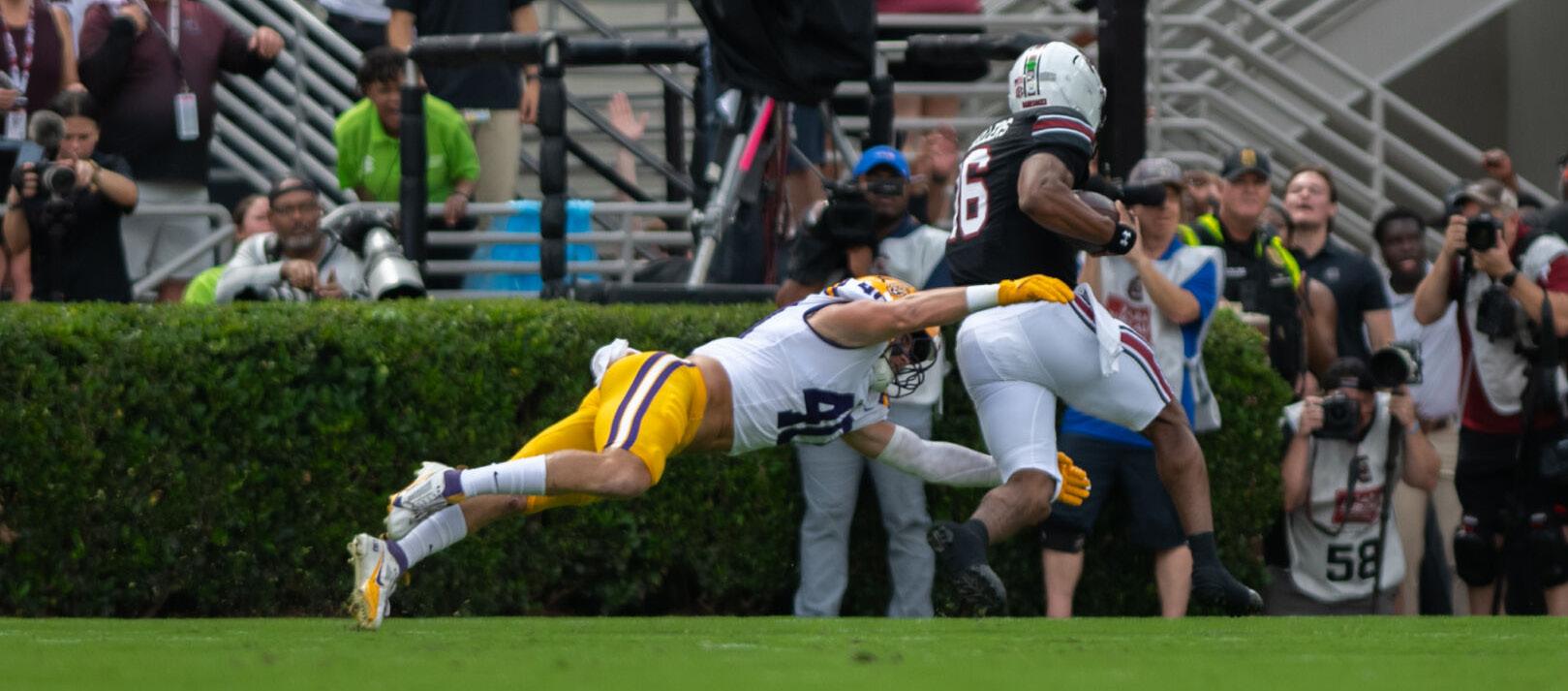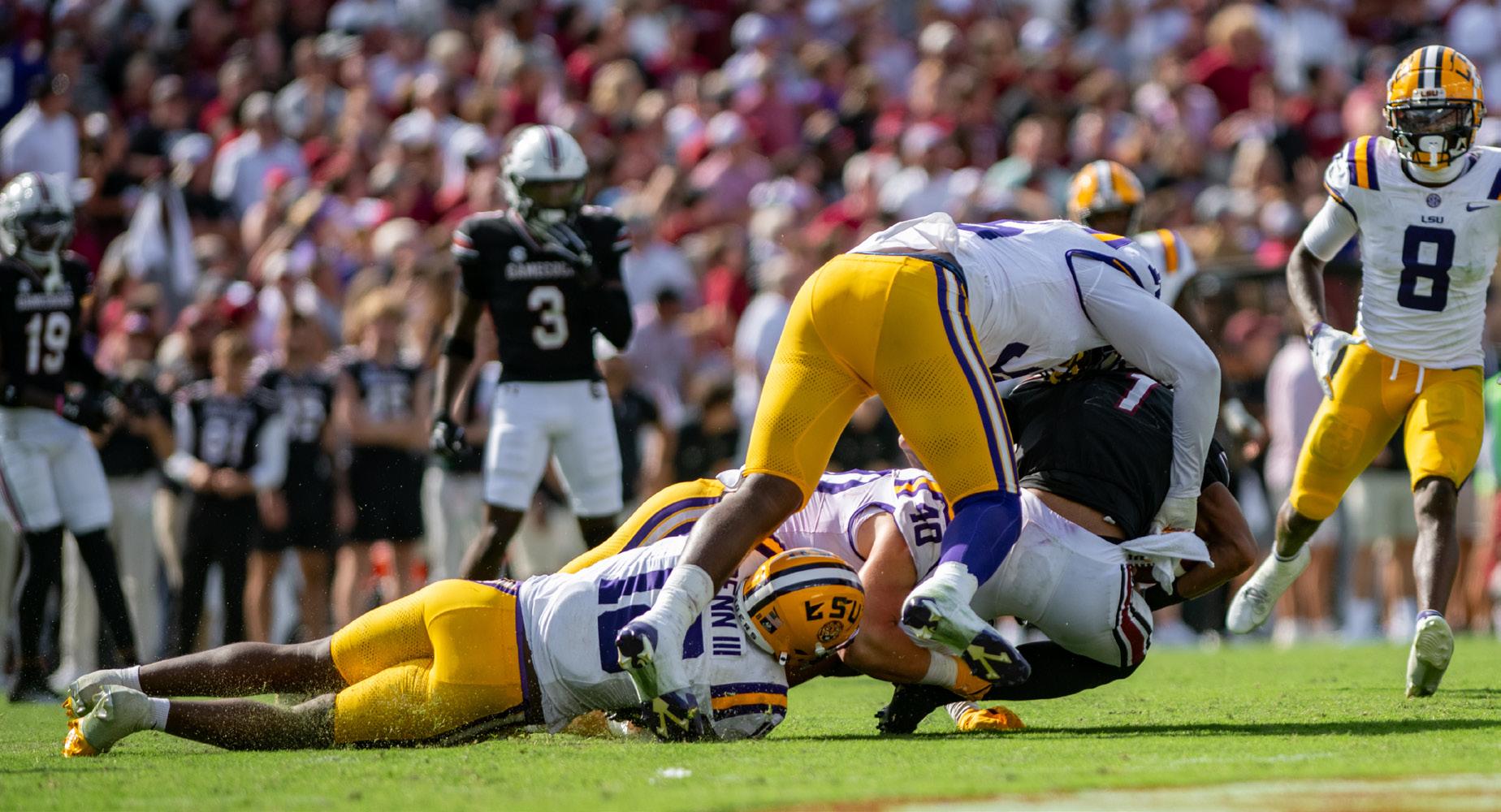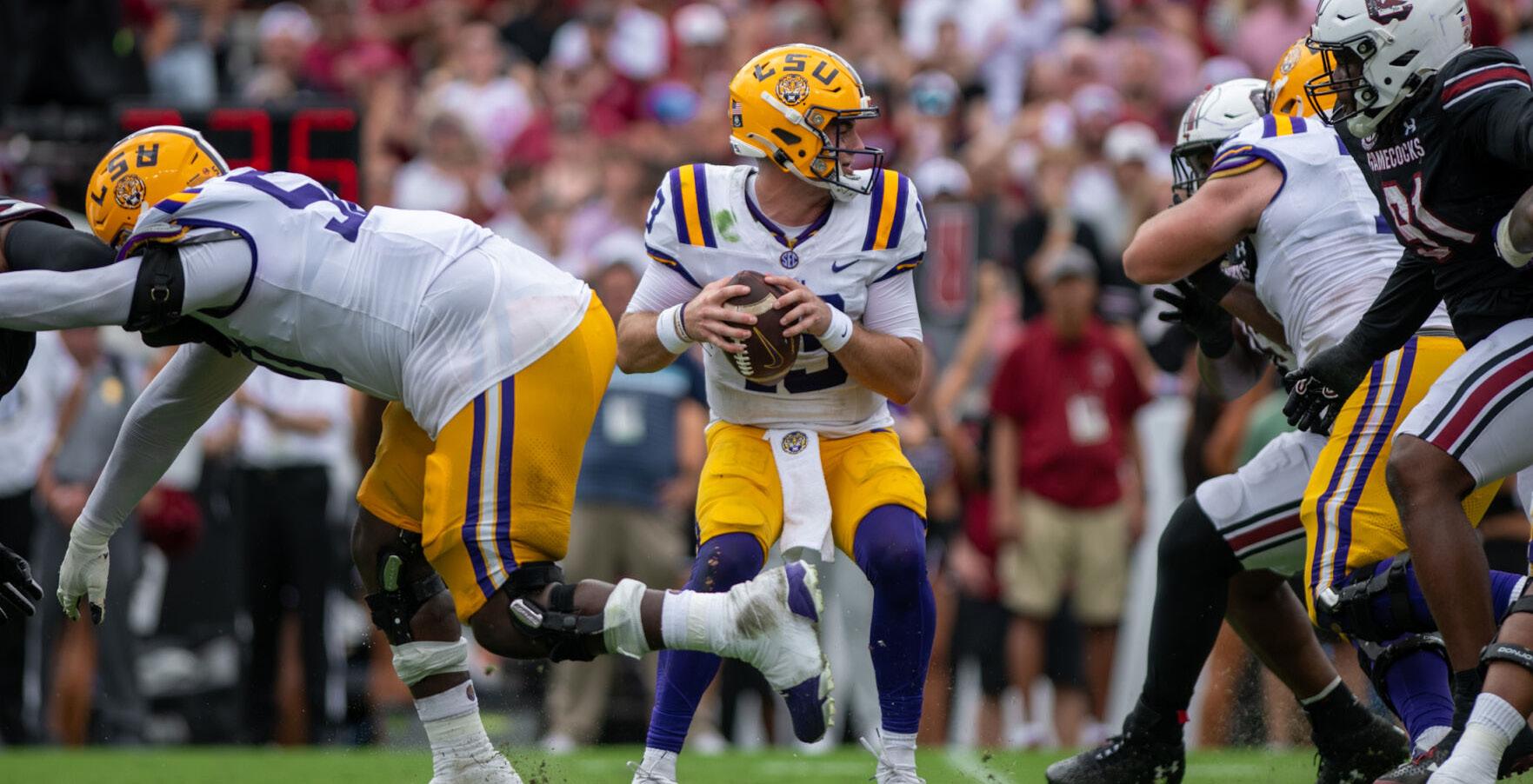

LSU scrapes by against South Carolina in 36-33 nail-biting victory.
LSU weathers the storm, sustains no major damage from Francine.










LSU scrapes by against South Carolina in 36-33 nail-biting victory.
LSU weathers the storm, sustains no major damage from Francine.







BY JOHN BUZBEE @thebuzzbuz
There were no classes Thursday morning.
LSU’s corridors and quads were populated only by muddy puddles and debris from the canopies of the resident stately oaks.
A few young souls cloaked in oversized hoodies and baggy sweatpants made their ways to the university’s dining halls. But just a few; the rest were either sleeping in or had evacuated.
They weren’t wading through standing water in rubber boots, clutching ponchos against heavy wind or bracing umbrellas to keep dry. Their eyes were instead glued to their phone screens as slippers flopped against the pavement.
Some were still hungover, with the smell of liquor on their breath from partying the night before. The weather was pleasantly cool albeit humid.
A short 48 hours before, experts and officials had forecasted Baton Rouge directly in the crosshairs of a mighty Category 2 hurricane, candidly named Francine.
How we got here
Francine, on Monday just a newly named tropical storm, was predicted by the National Hurricane Center in Miami to land on Louisiana’s west coast near the Lake Charles-Lafayette region.
Subsequent forecasts increasingly shifted Francine’s landing eastward.
By the time Hurricane Francine made landfall in Louisiana Wednesday evening, it was at Morgan City. The hurricane crawled north and lashed the Crescent City with 8 inches of rainfall, winds that reached 80 miles per hour and moderate flooding.
Francine’s status was downgraded the further north it climbed. It was a tropical depression by the time it reached central Mississippi.
Over 400,000 Louisiana residents were left without power in the hurricane’s aftermath, most of them concentrated in the greater New Orleans area, River Parishes and Northshore.
Gov. Jeff Landry said at a Thursday morning press conference he wasn’t aware of any fatalities from the storm. President Joe Biden had declared a state of emergency for Louisiana at the Louisiana governor’s request.
“East Baton Rouge Parish was largely spared the greatest impacts of this storm,” said MayorPresident of Baton Rouge Sharon Weston Broome at a Thursday morning press conference. “And for that, we are extremely grateful.”
Her sentiment was shared by many of LSU’s residents.
Over 10,000 were without power in Baton Rouge the morning after Francine.
Classes and offices at LSU would resume as normal on Fri-

day. The university closed campus and moved to virtual learning Wednesday and Thursday anticipating the storm.
This was done in an effort to prevent makeup days in the future.
Remote classes were supposedly held Wednesday but the university canceled them for Thursday.
The university announced a shelter-in-place order for residents from Wednesday morning to Thursday afternoon. The order was lifted earlier than originally planned on Thursday morning.
The dorm-bound hurricane experience
Mathematics freshman Samuel Patten expected worse from the storm. In the end it was just a matter of waiting it out so he could go back outside.
“The dorms kept power, air conditioning was still on, lights were still on,” he said. “Everything was all right. It wasn’t as nearly as bad as it could’ve been.”
When students realized the storm was of little worry, he said, many took to partying.
“I honestly couldn’t hear the storm, the rain or wind or anything,” Patten said. No louder than his neighbors, in any case.
“I thought more would happen,” said kinesiology freshman Khylie Black. She said it was the first time she, a California native, experienced a hurricane.
She’d expected, before the hurricane, felled trees with branches littering the pathways and pools of standing water.
She said half of her hall fled campus to take shelter at home.
Victoria Ludwikowski, a marketing freshman and native New Yorker, said it wasn’t her first hurricane. Compared to Hurricane Sandy, she said Francine was anticlimactic – not that it’s a bad thing.
She spent most of the storm watching television.
When much of her building got bored, residents scurried to the common spaces and stayed up late playing cards.
She was joined by business freshman Brynn Yaple, a native of Mandeville who remembers being out of grade school for two weeks because of Hurricane Ida.
Yaple and Ludwikowski said
BY JOHN BUZBEE @thebuzzbuz
In the immediate aftermath of Hurricane Francine, the streets of New Orleans flooded, winds raced at speeds of over 80 miles per hour and over 400,000 Louisiana residents were without power.
But LSU never lost power because of the storm, said university spokesperson Zach Labbe. The university weathered the wind and there was no unexpected flooding.
they’d both weathered worse storms that were completely unnamed. Just the aftermath of Ida, Yaple said, was worse than Francine.
Ludwikowski said the campus was eerily quiet the morning after. Save for the dining halls and occasional groundskeeper, there were hardly any signs of life, she said.
“It was so boring,” she said. “We just had to get out of there.”
They agreed that it seemed like the storm was forecasted to be worse than it was.
“They said it was going to be this big storm,” said communications freshman Tania Herndon. “But what I saw was just regular rain. It was pretty chill for the most part.”
The power went out “for like two seconds,” Herndon added, who evacuated campus to a nearby Baton Rouge neighborhood. Hailing from Washington, D.C., she said it was her first hurricane.
“It wasn’t even like a hurricane, I think,” said Jayne Carter, a psychology freshman from Washington who said Francine was also her first hurricane.
Carter was glad to see a lack of flooding, let alone lack of puddles around campus upon returning Thursday midmorning.
Herndon said the university’s communication was lacking regarding campus’ closing. She was disappointed, she said, that at one point the university had announced its intention to stay open while simultaneously telling students and residents to stock three days worth of food and water.
She believes some of the messages sent out by the university were inconsistent and untimely. She compared LSU’s announcements to Southern’s which had made plans to cancel classes about a day before LSU did.
“There wasn’t much they could really do,” Herndon said. “But there could’ve been better protocol and communication about closing. Everything was so last minute.”
Carter said everything fell into place as it should’ve been.
“It’s cool,” she said. “As long as we got our free day, I don’t really care that much.”
Much of Francine’s damage was concentrated in the state’s east. Baton Rouge Mayor-President Sharon Weston Broome said the city was “largely spared” from the storm’s worst.
Francine landed as a Category 2 hurricane near Houma and Morgan City before taking a path through New Orleans and the Northshore. Forecasters downgraded Francine’s status to a tropical storm and tropical depression within hours of landfall.
“There was no major damage to the campus.”
ZACH LABBE University Spokesperson
Muddy puddles and tree debris littered campus the morning immediately after the storm.
A few smaller trees had been blown unnaturally.
Labbe said Facility Services staff were at work on Friday to complete minor repairs. He said there wasn’t an exact figure for repair costs at this time.
Expected to be worse
Labbe said the university’s officials anticipated the storm would affect Baton Rouge and LSU’s campus more severely than it did.
Based on earlier forecasts, he said, the university expected heavier rainfall, winds and flooding. Essential personnel with the university’s Emergency Operations Center were activated ahead of the storm.
He said a curfew for campus residents was ordered, shelterin-place protocol was initiated, an emergency feeding plan was launched and backup power equipment was mobilized in the event of outages.
“Although the storm’s impact on Baton Rouge varied, we took all necessary steps to prepare for potentially harsher conditions,” Labbe said.
LSUReveille.com


B-16 Hodges Hall

Louisiana State University
Baton Rouge, La. 70803
(225) 578-4811
Managing
BUZBEE Digital
CHLOE RICHMOND News
OLIVER BUTCHER
COURTNEY BELL
Sports Editor JASON WILLIS
Deputy
LIZZIE FALCETTI
Entertainment Editor TOREY BOVIE
Opinion Editor
TAYLOR HAMILTON
Multimedia Editor ERIN BARKER
Production Editor EMMA DUHÉ
Chief Designer REI ZIMMERMAN
(225) 578-6090
Layout/Ad Design BEAU MARTINEZ
Layout/Ad Design CARLY LANGFORD
Layout/Ad Design AUDREY MORRIS
The Reveille holds accuracy and objectivity at the highest priority and wants to reassure its readers the reporting and content of the paper meets these standards. This space is reserved to recognize and correct any mistakes that may have been printed in The Daily Reveille. If you would like something corrected or clarified, please contact the editor at (225) 578-4811 or email editor@lsu.edu.
The Reveille is written, edited and produced solely by students of Louisiana State University. The Reveille is an independent entity of the Office of Student Media within the Manship School of Mass Communication. A single issue of The Reveille is free from multiple sites on campus and about 25 sites off campus. To obtain additional copies, please visit the Office of Student Media in B-39 Hodges Hall or email studentmedia@ lsu.edu. The Reveille is published biweekly during the fall, spring and summer semesters, except during holidays and final exams. The Reveille is funded through LSU students’ payments of the Student Media fee.

LSU football linebacker sophomore Whit Weeks (40) tackles an opponent Sept. 14th during LSU’s 36-33 win over South Carolina at Williams-Brice
BY JASON WILLIS @JasonWillis4
They say football is the ultimate team sport, where every player in every unit needs to contribute for a team to win.
Somehow, though, LSU has managed to win a whole lot of games in the last two years in spite of its defense, which was one of the worst in the school’s history last year.
This season, LSU brought in new defensive coordinator Blake Baker to establish an identity on defense: chaos.
That rang especially true in Saturday’s 36-33 win at South Carolina, where LSU’s defense was truly all-or-nothing.
Taking out sack yardage, LSU allowed 284 rushing yards for an average of 7.9 yards, continuing a trend of being unable to stop the run. Overall, the Tigers let up eight plays of 15 yards or more.
“We just gotta eliminate the big plays,” sophomore linebacker Whit Weeks said.
On the other hand, LSU was no doubt disruptive, coming up with five sacks and forcing three turnovers. Baker’s schemed-up pressure regularly got home to bother South Carolina’s signalcaller.
Those electric plays, plus a more refined performance in the second half in which the defense forced five three-and-outs (including one that minimized the burden of a turnover to just three points), were enough in the end for the Tigers to pull out a win despite trailing 170, making it the second-largest away comeback in LSU’s history.
“They’re not going to give up,” head coach Brian Kelly
said. “That’s not in their DNA.”
The defense tightening up allowed LSU’s offense to secure the lead for LSU, despite some struggles converting in short yardage. Josh Williams had what would become the gamewinning touchdown for the Tigers on a two-yard run with just over a minute left.
LSU stood tall on the subsequent final drive as South Carolina settled for a long field goal that it missed as time expired.
The LSU defense was aided in part by an injury to South Carolina redshirt freshman quarterback LaNorris Sellers, whose departure from an ankle sprain forced the Gamecocks to use backup Robby Ashford, who wasn’t as effective.
“It’s hard to say one way or the other,” Kelly said on if the injury changed the game.
For LSU, a win is a win. But it certainly wasn’t without a few headaches.
From the very start of the game, LSU was blasted off the ball and gashed for huge rushing gains by both Sellers and senior running back Raheim Sanders, allowing 48 rushing yards on just four carries in the first drive.
On the second and third defensive drives, senior cornerback Zy Alexander and sophomore cornerback Ashton Stamps each respectively came up big in the end zone. Alexander made a stunning grab for an interception that ended a Gamecock drive, and Stamps had a third down pass breakup to end another one with just three South Carolina points.
The next time out, after a blocked punt, Sanders needed just one play to run 10 yards almost uncontested past the LSU
defense to the end zone.
It was that kind of whiplash all day for the LSU defense. Glimpses of greatness, followed by the same old mishaps and errors.
Even with the success the unit found in the second half, it still looked helpless during an unbelievable 66-yard touchdown run in the third quarter where Sanders went completely untouched around the edge.
It’d be hard to argue that LSU hasn’t made progress on the defensive end from last season.
The Tigers are putting quarterbacks under duress and forcing turnovers. They’re doing what Baker wants: creating chaos.
Still, the good that LSU’s defense provided came with plenty of ugly plays. Is that sustainable for LSU going forward?
Kelly says no.
“We want to be better defensively, and we will,” Kelly said.
“All of it is correctable. All of it can be coached, and all of it can be executed.”
However, the defensive side of the ball certainly wasn’t all to
blame for LSU’s woes.
The offense gained just seven yards in the first quarter and failed to score in a goal-togo situation twice. The special teams had a punt blocked deep in its own territory, setting up an easy South Carolina touchdown, and also missed an extra point because of a bad snap.
Still, it’s hard not to shine a spotlight on the defense given LSU’s recent history. After a rousing win, the defense is still left with many of the same questions.
BY AVA HEBERT @avahebe4
LSU football achieved what it set out to do. It left South Carolina with the win of its first game on the road.
However, for most of the Tigers’ matchup against South Carolina, their fate was uncertain at best.
Until the final seconds of the game, South Carolina’s fanbase was huddled around the barricades, waiting to storm the field after a major upset.
It wasn’t LSU that prevented it from happening. It was a missed field goal that allowed the Tigers to take home the win.
From blocked punts to intercepted passes, it’s clear that LSU is not yet a championship-contending team. Nonetheless, the Tigers still managed to outscore the Gamecocks in their home stadium with a College GameDay atmosphere.
Here are three takeaways from the win.
LSU’s running game showed signs of improvement
In the Tigers’ home matchup against Nicholls, LSU’s running game was close to nonexistent.
Sophomore Kaleb Jackson led the Tigers in rushing yards in that game with just 28 yards on eight carries, while sixthyear senior Josh Williams came in second with 19 yards on four carries.
Because Nicholls used heavy seven- or eight-man fronts, LSU was forced to resort to a game heavily reliant on passing. South Carolina, on the other hand, didn’t load the box as much, allowing LSU to execute a more consistent run game.
“We’re just focusing on our process,” running back Josh Williams said. “We’re not thinking about the other team. We’re just doing it how we practice.”
Freshman running back Caden Durham took full advantage of South Carolina’s weaknesses. When the Tigers were struggling to make plays and score points, they looked to Durham
to pull them out of their slump.
“He does everything well,” Williams said. “For him to come into the game and perform the way he did… it was amazing for us.”
When LSU was down by 17 points in the second quarter, it was Durham who rushed the middle for 26 yards to secure the Tigers’ first touchdown and his own first career touchdown. Then again mid-third quarter, quarterback Garrett Nussmeier handed off the ball to Durham to score LSU’s first touchdown of the second half.
Durham led the Tigers in rushing yards with 98 yards on 11 attempts, complete with his two touchdowns.
Williams also added another touchdown to his career tally, giving the Tigers the lead over the Gamecocks late in the fourth quarter.
LSU’s ability to rely on its run game gave it a significant advantage over South Carolina.
BY JOHN BUZBEE @thebuzzbuz
LSU elected to close campus and move Wednesday and Thursday classes online ahead of dangerous weather from then Tropical Storm Francine, which has since been upgraded to Hurricane Francine. It was expected to make landfall in centralsouth Louisiana sometime Wednesday with Category 2 strength.
The decision to move classes online and not cancel schooling altogether inspired some strong reactions in the LSU community.
“Can’t wait to get told to turn on my zoom camera while my roof gets torn off my apartment,” said computer science junior and Speaker Pro Tempore of the Student Senate Ethan Elmer in a post on X (formerly Twitter).
His sentiment was shared by other commenters on X and a sizable number of students and faculty before they left frustrated on Tuesday.
To them, it doesn’t make sense to rely on a system wherein faculty often had little time to prepare and are dependent on favorable internet, and more broadly, both parties having not lost their power.
Assistant Vice President of Marketing & Communications Kristine C. Sanders said the university came to this decision because if more than one day of class is canceled, the uni-

BY AIDAN ANTHAUME @aidanth
Gov. Jeff Landry’s proposal to revive the tradition of bringing LSU’s live tiger mascot, Mike VII, onto the football field has sparked concern among students, many of whom have voiced strong opposition to the idea.
While the plan might evoke a sense of nostalgia for some, the majority of students believe the potential harm to the tiger far outweighs any entertainment value.
“Obviously it would be exciting to see, but if the research is there that this is not tolerable for the tiger, then no matter how fearsome or strong the tiger looks then overall it’s probably not a good deci-
sion,” said computer science freshman Ford Carver-Dews.
“It’s already controversial to some people that we even have a live mascot on campus,” CarverDews said. “Being able to see this tiger on our campus is cool, so I wouldn’t want to spoil that by doing anything to harm the tiger.”
Just last week, People for the Ethical Treatment of Animals sent a letter to Landry urging him to drop his request.
“No one wants to be put in a tiny box,” Randy Quincey, a senior film and television student, said. “If bringing him out and putting him in that tiny cage adds additional stress I don’t think it’s worth it. I’d just rather the tiger be safe.”
The last time Mike made an ap -
pearance on the sidelines was Mike VI in 2015 at the eventually canceled McNeese game. Three years later, when LSU adopted Mike VII, they announced the end of this tradition and coined it as “responsible care for live exotic animals” according to the Louisiana Illuminator.
As biological sciences freshman Anastasia Stanis put it, “With exotic animals, it’s probably best we don’t put him under stress. You never know what a tiger can do.”
“Keeping him calm and keeping him relaxed in his habitat is probably the safest option,” Stanis claimed.
Some students aren’t entirely
BY SARAH WALTON @sarahrosewalton
Last month, Gov. Jeff Landry signed an executive order banning the instruction of critical race theory in public K-12 schools, referring to the course of study in a press release as a divisive concept that “instructs students to view life through the lens of race and victimhood.” The release continued by saying Landry instead wishes to push “American Exceptionalism.”
Heather O’Connell, an LSU sociology professor, gave her reaction to the news and her thoughts on what is next. “It’s surprising, this theory isn’t really something you learn directly until you get to the university level, probably not until your
graduate studies if you were to go that far in education,” she said.
According to O’Connell, critical race theory doesn’t exist in a vacuum, and is a perspective that is supposed to help people understand social structures.
“The ban is covering any critical attention to racialized issues in the United States and how that’s talked about,” O’Connell said. One section of the ban covers teaching students about someone being inherently racist based on their identity. “That’s not CRT. CRT doesn’t really pay attention to individuals at all. It’s much more structurally focused. I guess we’re calling it a CRT ban because that’s what people are used to saying,” O’Connell said.
When asked about why someone would be upset about taking a critical look at social structures and how they relate to race, O’Connell chuckled. “Most of the time, the people that are upset about it, are the people that have something to lose by questioning how those institutions work,” she said.
On how this executive order and other actions like it would affect students, O’Connell said there may end up being a disparity in education that could harm Louisiana residents when they get to college.
“One of the key words in critical race theory is the word, ‘critical,’” she said, noting how important critical thinking skills are for college and how, “it encourages you to question
BY CADE SAVOY
Delta Tau Delta’s LSU chapter, Epsilon Kappa, has drawn criticism after displaying a banner in the lead-up to LSU football’s Saturday matchup against Nicholls State that read, “What do Nicholls + Palestine have in common? Getting BOMBED.”
At a time when AP News reports that the death toll in Gaza has exceeded 40,000, DTD’s banner has drawn criticism from a substantial number of LSU students who say the display is insensitive, racist and out-of-touch.
Among the fraternity’s most outspoken critics is Mia, a freshman English major who has agreed to speak to The Reveille under the condition that her last name be kept anonymous.
After making a post on Snapchat speaking out against DTD, Mia said she has received dozens of hateful messages from supporters of the fraternity, prompting her to hide her identity for fear of further harassment.
“Absolutely disgusting,” Mia said of DTD’s banner. “Whether you agree with Israel or not, I don’t see how making fun of Palestinians being slaughtered is funny.”
DTD has yet to release an official statement addressing the controversy and didn’t immediately respond to a request to comment. LSU Greek Life has not formally levied any disciplinary action against the fraternity, though, according to Mia, several civil rights complaints have been submitted to the university’s Office of Civil Rights and Title IX.
For Mia and many other concerned students, LSU’s silence has been deafening.
dominant narratives.
Stephen C. Finley, the chair of the LSU African and African American Studies Department, saw the executive order as part of a wider push to limit discussions surrounding race.
“It’s not just CRT in isolation. It’s this move against DEI and any such programs that are coded as Black,” he said. “Even though these programs don’t benefit Black people very much.”
Finley called these bans political signals that are “a part of a wave of coded politics across the country that are anti-Black, but that are also a signal to white people that they are going to be a priority.” He said
Having been on campus for only two weeks, Mia expressed disappointment with LSU’s response to DTD’s actions. “I had this expectation that college would be different. When I was in high school, I was told ‘this won’t fly in college.’ But now I see it differently.”
To others, the university’s failure to immediately hold DTD accountable is par for the course.
“The banner was genuinely disgusting, but not very surprising for fraternities on campus,” said political science sophomore Gabriela Juárez.
For Juárez, who serves as the secretary of membership for student organization Students for a Democratic Society, LSU has a long history of allowing fraternities to get away with bad behavior – and
ONLINE, from page 4
versity is required to make up those missed days. That could have an impact on fall break or necessitate Saturday make-up classes like in the aftermath of Hurricane Ida.
“We recognize that some students may have issues logging on in this situation, and that some faculty or students could potentially lose power or internet during the storm,” Sanders said in a statement. “So we are urging students who have difficulties to stay in direct contact with their professors so they can discuss individual needs.”
She said LSU has a remote learning plan that addresses this situation. She added that this conclusion came at a balance to preserve LSU’s educational mission while keeping its community safe.
from page 4
failing to condemn anti-Palestinian violence.
Last May, in response to a protest led by pro-Palestinian students demanding that LSU divest its endowment from Israel and companies supporting Israel, a group of counter-protesters attempted to disrupt the pro-Palestinian group’s protest by chanting, “Palestine has zero national championships.”
A statement from LSU spokesperson Todd Woodward commended the protestors for “holding a civil
BAN, from page 4
the sentiments are meant to tell white people that the new legislation is meant to prioritize “protecting their rights, their privileges, their benefits, their way of life.”
In relation to the misunderstanding and misuse of CRT in discourse, Finley referenced how Florida banned the Advanced Placement African American Studies course and how the same problems are arising in Georgia.
“My fear,” Finley said, “and this is why I called it anti-Black, is that it will merge and be aggregated, such as in Florida, as a tool against things like African American Studies.”
Finley’s fear goes farther
protest,” but made no comment on either cause.
To Juárez, LSU’s continued refusal to address anti-Palestinian violence on campus “sends an incredibly clear message, especially to Palestinian students who are watching their school actively support a genocide of their people.”
When asked what kind of disciplinary action LSU should bring against DTD, both Mia and Juárez drew comparisons to a similar incident in which LSU’s chapter of Delta Kappa Epsilon displayed a banner mocking the 1970 Kent State
than African American studies. He says if they begin to get rid of courses like the AP one, it will allow room for women and gender studies and LGBTQ+ studies to also be censored or completely gotten rid of. His reasoning for believing this goes back to knowledge that “the same logics against those are rooted in anti-Blackness.”
He also points to the idea that some want to get rid of these studies because they highlight the experience of people of color and historically marginalized communities in the U.S. and “question the American mythology.”
“It is a religious mythology that America is a meritocracy,” Finley said. “... It’s not about merit. It is often about skin col-
Massacre.
Propelled into the national spotlight in 2013, the DKE controversy prompted LSU to condemn the fraternity and force it to issue a public apology. LSU’s chapter of DKE has since disbanded due to hazing allegations.
Juárez said that most LSU students have long been dissatisfied with the behavior of fraternities on campus – DTD and beyond. “The discourse has already met this occasion. It’s time we do something about racism and sexual abuse in fraternities.”
or, gender and who you know. And all those other things rather than hard work, grit and intelligence and creativity.”
Finley pointed out what he saw as the real reasons behind the anti-CRT push. “Anti-CRT serves as a stopgap for educating the populace about the reality of experiencing America, especially if you’re Black or Brown. Or gay or lesbian,” he said. “It’s all about consolidation. And when I mean consolidation, I mean making sure those who have always benefited from the system continue to benefit.”
“How can America be better without dealing with itself much more honestly?” Finley asked. “But this isn’t about honesty. It’s about benefit, and who
MIKE, from page 4 against the idea, but approach it with caution.
“It would be a nice feature to give the team a really cool introduction,” Elijah Troupe, a sophomore journalism major, said. “But I definitely think that they should do it cautiously if they do it at all. It might catch some unwanted attention,” he said.
This is not the first time Landry has commented on LSU athletics. In April, Landry received concerns from a national free speech organi-
benefits, and who the mythology and system says has a right to benefit and who doesn’t.”
To close, Finley asked questions he’d leave for those who have learned about Landry’s legislation and other actions like it.
“I would ask people to take a look beyond their own boundaries, beyond their own comfort level, and see who this affects more than others,” Finley said. “That will give you a key about what it means, and how it’s meant to function. And have them ask themselves if that matters to them. If that doesn’t matter to them then they have work to do, some self awareness work. If it does matter, they have work to do, but the work is out there.”
zation after asking LSU to require student athletes be present during the national anthem.
As some students see it, this is just another attempt for Landry to win the ‘old school’ demographic.
“I think he should stop trying to score culture points,” said psychology sophomore Nick Murphy. “It feels like he’s more interested in making headlines than making a difference,” Murphy said.
Despite Landry’s push to get Mike back in Tiger Stadium, LSU announced Mike VII will remain in his habitat, safe from the spotlight.







LSU football beats South Carolina 36-33 at William-Brice Stadium in Columbia, SC on September 14.





BY MARTIN SULLIVAN @marty_sulli
LSU alumna and former national champion Angel Reese suffered a season-ending injury Friday night. The news cuts short a dominant first season with the Chicago Sky.
Reese dropped the news of her injury status on social media Saturday night, later sharing with her followers that she suffered a hairline fracture in her left wrist.
The fracture came following an and-one bucket against the Los Angeles Sparks Friday night. Reese underwent surgery Tuesday.
“The risk of not having surgery, I could literally have arthritis at 22 years old,” Reese said on a livestream. “That wasn’t an option.”
She says she expects to return to normal in six weeks, just after the WNBA season ends.
“I am finally able to give myself a physical and mental break,” she said in her post.
The WNBA has one of the quickest turnarounds from college to pro in all of sports. Reese had just over a month between her last game with LSU and her first game with the Sky, not to mention preseason training and the draft.
Despite a shortened season, Reese still managed to break plenty of WNBA records.
She now holds the league record for rebounds, rebounds per game and offensive rebounds in a season, as well as the record for consecutive double-doubles.
She also had the second most double-doubles ever by a rookie and is the fifth rookie ever to average a double-double.
This is all while missing six games. The 2025 WNBA schedule expanding from 40 to 44 games should instill fear into all rebound and double-double record books.
Reese was able to transfer her abilities from college to the pros almost immediately. All season, she has dominated the board, imposed her will on defense and drawn consistent fouls.
LSU VS USC, from page 8
It relieved some of the weight from Garrett Nussmeier’s load, and allowed the Tigers to diversify their offense.
LSU’s defense has holes South Carolina running back Raheim Sanders saw the hole. After getting the handoff from quarterback LaNorris Sellers, it was there. A straight path to the end zone.
LSU’s defense remembered it all too well. It was like deja vu from its previous matchup against the Colonels, where

MORGAN COOK / The Reveille
LSU women’s basketball junior forward Angel Reese (10) waits to be put in March 3 during LSU’s 77-56 win against Kentucky at the Pete Maravich Assembly Center.
She averaged 13.6 points, 13.1 rebounds and 1.9 assists per game on the season.
In her final game on Friday, she finished with 24 points and 12 rebounds in 32 minutes.
Irreplaceable a piece as Reese is, the Sky still have their eyes on the playoffs. Reese plans to contribute in every way she can to achieving that end.
“She’s tough, she walks in here with a great amount of energy, she’s energizing everybody else, she’s encouraging everybody else,” Sky head coach Teresa Witherspoon said. “She’s been super strong, were going to be just as strong for her.”
The Sky currently sit as the eight-seed in the playoff picture, which represents the final spot in the postseason. They’re one game ahead of the Atlanta Dream and two games ahead of the Washington Mystics. They’ll play both teams once before playoffs begin.
Isabelle Harrison is set to replace Reese in the starting lineup. She shined on Sunday, producing 21 points and nine rebound in 33 minutes.
Regardless of the season’s outcome, the Sky have begun to lay a strong foundation for their future.
running back Collin Guggenheim made a similar long run on LSU’s defense.
“We wanna be better on defense,” Kelly said. “All of this that you saw today… all of it is correctable. All of it is coachable.”
Not all aspects of the Tigers’ defense were bad.
For instance, defensive end Bradyn Swinson had an exceptional game, recording three sacks and five total tackles.
Whit Weeks also positively contributed to the Tigers win by leading in tackles with a total of 11.
BY LIZZIE FALCETTI @lizziefalcetti
Signs and flags flew through the air in a misty Columbia, South Carolina, for College GameDay.
Thousands of people, mostly in garnet and black, some in purple and gold, huddled together to watch the names that carry college football each Saturday morning: Corso, Herbstreit, Fowler, McAfee, Howard, Davis and Saban.
At the end of the pregame show, college football legend Lee Corso wore the Mike the Tiger mascot head, and LSU went on to defeat the Gamecocks 36-33 in a back-and-forth battle.
After starting the game in a 17-point deficit, the Tigers came back and had an explosive second half.
With five seconds to go in the fourth quarter and trailing by three, the Gamecocks kicker Alex Herrera missed a 49-yard field goal.
“This group is going to battle,” head coach Brian Kelly said. “It may not be the cleanest. We’ll continue to coach them because they want to do so well for LSU. They want to do it the right way, and they are going to work at it.”
Quarterback GarrettNussmeier led the Tigers with 285 passing yards and two touchdowns, which helped contribute to the LSU win.
Tiger freshman running back Caden Durham had two touchdowns and 98 yards, scoring his first career touchdown in the opening half.
To start the game, the Gamecocks powered down the field with ease to get to the Tigers’ four-yard line.
South Carolina Quarterback LaNorris Sellers ran the ball to the right for four yards, diving into the endzone for a touchdown. At the end of the first quarter, the Gamecocks had 127 yards of total offense. LSU only had seven.
A major theme throughout the first half was Sellers’ dual-threat capability. With an LSU defense that is still trying to find itself, Sellers created offensive opportunities with his legs multiple times.
However, Sellers left the game right before halftime with an injury and Robby Ashford took over.
Along with Sellers’ 88 rush-
“I think our defense played physical, fast,” Weeks said. “We just gotta eliminate the big plays coming up for the next few weeks of our season, and we’ll be all good.”
The Tigers struggled to defend the run game, allowing 243 rushing yards with four touchdowns.
Although LSU’s defense wasn’t completely to blame for the closer-than-expected matchup, it certainly played a role.
With upcoming matchups against big-name teams like UCLA and Ole Miss, the Tigers will be forced to figure out what
ing yards, South Carolina running back Raheim Sanders had 143 rushing yards.
When the Gamecock defense blocked a punt to set up its offense on LSU’s ten, Sanders ran the ball 10 yards to extend the lead by 17 in the second quarter.
“We believe it was an illegal block,” Kelly said of the punt. “We voiced our concern with it. We will address it with the SEC officiating crew.”
The Tigers finally responded with eight minutes left in the half. Freshman running back Caden Durham rushed the ball for 26 yards into the endzone. It was his first career touchdown.
“He did an unbelievable job tonight… especially as a true freshman, that’s unbelievable,” Nussmeier said about Durham.
After the Tigers kicked a field goal to make it 17-10, Sellers answered with a 75-yard run up the middle. It was the longest run by a South Carolina quarterback.
The Tigers then scored when Nussmeier threw a 12-yard pass to receiver Kyren Lacy. LSU was trailing by eight to end the half after a bad snap on the extra-point attempt.
The Gamecock defense continuously broke through LSU’s offensive line. With a Tiger offense that relies heavily on Nussmeier’s ability to move the ball forward, the constant pressure was setting LSU back.
To open the second half, the Tigers drove down the field to the two-yard line, but South Carolina forced a turnover on downs on 4thand-goal.
The next LSU offensive drive, Durham rushed to the left to score a nine-yard touchdown, and LSU went for two, but Nussmeier was sacked.
The Tigers were still down 2422 entering the fourth quarter. But then, Nussmeier threw a touchdown pass to Tight End Mason Taylor, and LSU took its first lead of the game.
Minutes later, Sanders rushed for a 66-yard touchdown. South Carolina went for two but couldn’t get it.
Down by one, the Tigers fumbled a snap on their own 24-yard line, and the Gamecocks went on to score a field goal with ten minutes left.
LSU then drove down the field. But in the red zone, Nussmeier threw an interception at the goal line.
The next drive, with a little less than two minutes to go in the fourth quarter, Nussmeier threw a dart receiver to Kyren Lacy, which put the Tigers at 1st-and-goal.
“You would’ve never known that he made a mistake,” Kelly said. “He can forget those plays and move onto the next, and that’s what you have to be to be a quarterback in the SEC.”
Running back Josh Williams scored, and LSU took a 36-33 lead with a minute left.
“They fight like LSU Tigers,” Kelly said. “That’s what we want for our fans. That’s what they want for their family. That’s what they want for their teammates. They showed that today.”

works for them on defense.
And if they don’t? The playoffs won’t be an option for the Tigers.
LaNorris Sellers’ injury acted as LSU’s saving grace
With five seconds left in the first half, Sellers grabbed his ankle after a sack, clearly in pain. He tried giving it a go for a short second half drive, but he was out of the game.
Redshirt senior Robby Ashford came to take his place, giving the Tigers a glimmer of hope for the outcome of the game. Ashford spent more time in
the pocket, allowing LSU’s defensive line more time to get past South Carolina’s heavy offensive line.
“They were able to stay on schedule earlier with Seller in the game,” Kelly said. “When Ashford came in we were able to get them off schedule.”
The momentum shift towards the Tigers also contributed to their offensive run in the second half.
Although the win can’t be attributed as a direct result of Sellers’ injury, it was definitely a contributing factor to the Tigers’ second season win.
BY EMILY BRACHER @emily_bracher_
The Merriam-Webster dictionary defines the word “strange” as “different from usual.” Its definition of “fauna” is “animal life.” The words put together is something that Louisiana has a lot of, which has inspired the state’s artwork and culture for generations.
Strange Fauna uses zero waste values to create art about ecology. Founder Amori Bieller started selling up-cycled wearables in 2020. The name of her business was inspired by her childhood filled with playing with weird critters outside in New Orleans.
Bieller makes and sells art that includes wearables from clothing to jewelry as well as her own paintings. These products require little to no waste production, Bieller said.
Bieller’s goal for the fall is to transition to a more virtual platform as well as partnering with more local stores in Baton Rouge. She said that by doing this, she would help bridge the gap between artists and “eco -

logical responsibility.” Some of her biggest partnerships have been with Bellyfire Studios, Riverbend Gymnastics and Beaver’s Abundance.
“This would require more partnerships with local sustainability initiatives and wildlife societies to spread awareness and educate people about conservation and waste management,” Bieller said.
Everything sold by Bieller is made by her and created out of donations, trades and secondhand purchases. Items such as food scraps, seeds, used jewelry and cloth are all used to make
her artwork, she said.
She takes food waste such as turmeric, onion skins, cabbage, beets, etc. to create pigments that are used to dye her clothing items. Her clothing items usually include animals, insects, abiotic ecology prints or paintings.
“Food waste, being a monumental source of greenhouse gasses and landfill waste, are put to use here,” Bieller said.
Her jewelry is made out of unwanted old jewelry that she disassembles and makes into her own. Other items include her seed bombs that are made out of donated shredded paper and seeds that can be found at Local Supply, she said.
Bieller’s paintings are made with “whatever she can get her hands on,” such as recycled frames, discarded wood, cardboard and records. The most exciting part about her painting process is the actual making of her paints, she said. This includes experimenting how to make watercolors and gouache with plants, flowers, rocks and berries that she forages herself.
“I decided to do this after




learning that paint is one of the most abundant microplastics in our oceans and that acrylic paints are typically petroleum based,” Bieller said. “So, instead of buying new paint in plastic bottles, I have been replacing them with ones I make myself. Slowly, I have incorporated more of these colors into my paintings, and my plan is to exclusively use them one day.”
While Bieller is a business owner, she is also a full-time student at Louisiana State University. The junior is majoring in renewable natural resource ecology and management, with a focus in conservation biology. She is also minoring in oceanography and environmental science.
She said that it has been a major learning curve managing both, but something that has been incredibly rewarding. Everything from accounting to public relations to advertising is all done by Bieller. Having to manage everything by herself has taught her to work with herself instead of against, she said.
Looking back, Bieller said that her life has come full cir-
cle. She was once a little kid that spent her time outside fishing, catching bugs and building things with sticks. Now, at 24, she spends a majority of her time studying wildlife and global cycles. Her free time outside of that consisted of making artwork based off of those topics, she said.
“I realize now that what I spent time doing outside as a child was scientific in nature – observation and discovery –and I used art as a way to compartmentalize occurrences that I found fascinating or did not quite understand,” Bieller said. “That is largely what I do now, only much more technical and structured.”
For more information on Bieller and Strange Fauna, check out her Linktree. Whether it is through her, or other business through Baton Rouge, Bieller said to look out for what is made ethically and sustainably.
“Strange Fauna really became a brand completely embodying my life. From my interests to my passions to my personal development, it is all in my work and message,” Bieller said.










JEMIAH CLEMONS @MICLEMAH
What seemed like a normal day for Apalachee High School students soon turned into a nightmare. On Wednesday, Sept. 4 shots rang out wounding nine and killing four people. The suspect, 14 year-old Colt Gray, has been arrested and charged with four counts of felony murder.
The U.S. has developed quite the routine after a school shooting occurs; condemn the shooter, debate gun laws, then send thoughts and prayers. It’s a tragic cycle, but there is one thing about this shooting that sets it apart from the rest. Colin Gray, Colt’s father, has also been arrested and charged with
second-degree murder, involuntary manslaughter and child cruelty. He could face up to 180 years in prison.
Charging Gray for the heinous actions of his son is a step forward for this country concerning school shootings. Parents should be held accountable for giving their children access to guns and not teaching them proper gun safety.
Georgia Law enforcement did a thorough investigation and warned both Gray and the county that Colt was a danger to himself and others. Colt used Discord to spew hatred and threats of violence, and this alerted the Georgia Bureau of Investigation (GBI) to his behavior, according to reporting by the Washington Post.
Notably, Colt’s username was “Lanza” in Russian. This is relevant because it’s a reference to the Sandy Hook school shoot-
er, Adam Lanza. This alarming behavior signaled the GBI and they met with Colin about Colt’s online antics. In defense of Colt’s Russian username, Colin told law enforcement that they did not speak Russian.
When asked about firearms, the father told law enforcement that Colt didn’t have ready access to the guns in his home, but was allowed to use them when supervised. After concluding the investigation, it was revealed that Colin was in possession of at least six firearms. It’s because of shocking discoveries like this that parents must share the legal responsibility of such inhumane crimes.
The parents of the Oxford High School shooter were sentenced to 10 years in prison. This case set a new precedent for law enforcement nationwide. It forces parents to pay more attention to their children both in -
side and outside of school. With new social media platforms it can be difficult for parents to track their children’s activity, but it shouldn’t take mass shootings for them to pay attention.
This new trend may also influence people to be responsible gun owners. Firearms should be unloaded and kept in a locked safe with ammunition in a separate location. Other household members should also be responsible for knowing gun safety. Access to these weapons should be fully restricted from children and guests of the home.
Colin allowing his son Colt to use his weapons was already a red flag, but unfortunately, so many gun owners allow their children to use firearms for hunting. Gun ownership is so engraved in American culture that sometimes people forget the purpose of a gun is simply to kill. It’s not meant for child’s play.
Following simple guidelines and being a responsible gun owner can potentially decrease the amount of school shootings in this country. This may also decrease the number of people who want to have guns abolished altogether. Firearms aren’t inherently a bad thing, but when owners become neglectful that’s when people get hurt or killed.
It’s clear that gun reform is not happening anytime soon, so punishing parents for their children’s crimes may be an effective short-term solution. There definitely needs to be congressional intervention, but for now this will have to do. As sad as it is, keeping an eye on your children and your weapons is key to ensuring safety in schools today.
Jemiah Clemons is a 20-yearold kinesiology junior from Miami, Florida.
If you didn’t already know, bus etiquette is very demure

GARRETT’S GAVEL
GARRETT MCENTEE @9are_bear
LSU’s bus system: the Tiger Trails are an everyday feature in my life. In all honesty, the buses kind of run my day, and I plan everything around them. They also have a special place in my heart and, by association, so do the bus drivers.
If you’ve ridden a bus, you’ve met them, our angels behind the wheel. They take care of us, so why don’t we take care of them?
I’m not saying that we need to buy them dinner or anything, but why don’t more students make use of some good ‘ole southern manners?
In my time as a passenger, I can count on one hand the amount of “Thank you kindly”’s that have been uttered toward a driver. Y’all have no manners. Disgraceful. But fear not, because the good ‘ole country boy that I am has manners in spades...
Firstly, let’s discuss how you should conduct yourself whilst you await the chariots that are the Tiger Trails buses.
1. Keep to your own space.
While waiting at the bus stop, one should always ensure that they’re mindful of others in terms of space and personal volume. A little chattering between friends never hurt a soul, but there’s no need to shout at the bus stop.
2. When the bus arrives you may NOT push and shove others to get on the bus. I know getting to where you’re going is so exciting, but have some decorum, people.
Next, we’re going to cover how to get on the bus and how to conduct yourself during the trip.
1. First off, say hello to your bus driver, offer a nice wave or a courteous smile. It’s the polite thing to do.
2. Now, as you are trying to find your seat, assess the size of the crowd. This is also the perfect time to make note of any pregnant passengers, elderly folk or anyone who looks like they may need a seat more than you. If there is, give up your seat. If it’s a small crowd with no one from the aforementioned list on the bus, then you may sit wherever you like. If there is a big crowd then attempt to move to the far backside of the bus and fill in any gaps to maximize space. Be prepared to stand if you’re able to.
3. When you find your seat

or handle, you may sit in silence or soft conversation with your neighbor should they be amenable to it. Better to say they won’t be unless y’all have some previous repertoire.
The bus is getting to your stop, what now?
1. Calmy pull the yellow line right above or next to where you are sitting and begin to collect your baggage. When the bus
rolls to a stop, get up calmly and ensure that none of your items smack anyone next to you.
2. If you leave out the front exit closest to the bus driver it’s a sign of a good person to say, “Thank you” or “Have a good day.” Keep that in mind. Even if you get off the bus through the back exit, consider doing the same. It could really make someone’s day to know that they’re
The Reveille (USPS 145-800) is written, edited and produced solely by students of Louisiana State University. The Reveille is an independent entity of the Office of Student Media within the Manship School of Mass Communication. Signed opinions are those of the author and do not necessarily represent the views of the editor, The Reveille or the university. Letters submitted for publication should be sent via e-mail to editor@lsu.edu or delivered to B-39 Hodges Hall. They must be 400 words or less. Letters must provide a contact phone number for verification purposes, which will not be printed. The Reveille reserves the right to edit letters and guest columns for space consideration while preserving the original intent. The Reveille also reserves the right to reject any letter without notification of the author. Writers must include their full names and phone numbers. The Reveille’s editor in chief, hired every semester by the LSU Student Media Board, has final
appreciated for their efforts. Congratulations. You made it off the bus and did so in a respectful manner. Remember, these drivers are providing a service that you should be thankful for. It never hurts to show a little kindness to someone, especially when they deserve it.
Garrett McEntee is a 19-yearold English sophomore from Benton.



